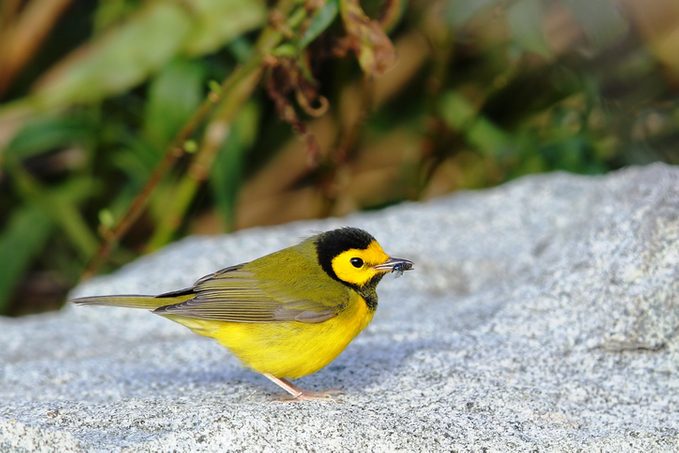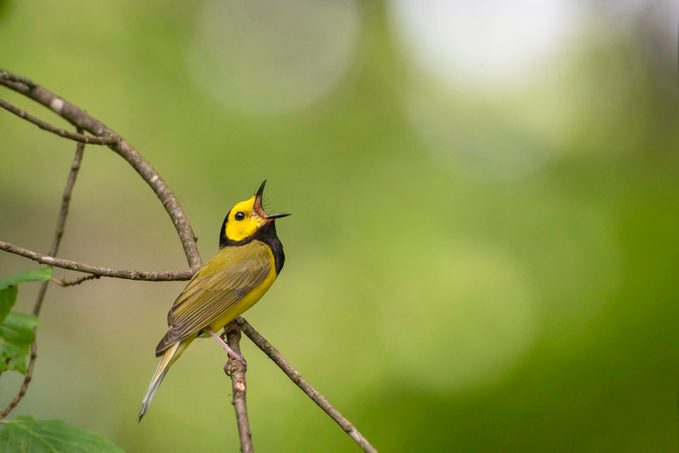Learn what a hooded warbler looks like and where to spot one. Plus find out what hooded warblers eat and learn about their nesting habits.
How to Identify a Hooded Warbler
On This Page
What Does a Hooded Warbler Look Like?

To identify a hooded warbler, look for a small yellow bird with a distinctive black hood around its face. The bird’s wings are noticeably a darker olive color than its sunny yellow belly.
Females resemble males, but where males have solid black “hoods,” females’ hoods are patchier. In some cases, the hood can be absent entirely.
“The hooded warbler is a fairly easy one to identify,” says Dr. Kevin McGowan, senior course developer at the Cornell Lab of Ornithology. “The male is beautiful. Some warblers look like they have beautiful colors painted on, but the hooded warbler looks yellow all the way through. It’s a very solid warbler.”
Be on the lookout for white tail feathers, which are most prominent when the bird is flicking its tail as it hops through underbrush.
“When they’re foraging along, they’re constantly flicking their wings and flashing the white spots in their tail,” Kevin explains. “That flushes up insects that they then catch in flight. The tail spots are used by a number of different warblers, but the hooded warbler is quite noticeable. It’s pretty cool.”
Hooded Warbler Range and Habitat

Kevin notes that while the hooded warbler was once a southeastern bird, throughout several decades, its range has shifted. “It’s been increasing its range northward over the past 40 years or so, as have some other warblers, too,” he says. “It’s basically a southeastern warbler, but it’s getting to be regular much farther north.”
These birds then fly south across the Gulf of Mexico to spend winter in warm, tropical areas.
Unlike many warblers, this species forages, and even nests, close to the ground. You’re more likely to find one in their ideal habitat—shady undergrowth during summer breeding season. Look for hooded warblers in the understory of rich, moist woods, and on the edges of swamps.
Hooded Warbler Hotspot
Any one of Indiana Dunes National Park’s hiking trails through prairie, savanna, beach and dune habitats will net plenty of good bird sightings, but the two best trails for birders are Trails 2 and 10. Take Trail 2 and enjoy a mile-long boardwalk where you can spot nesting woodland birds like the hooded warbler, veery and red-shouldered hawk.
Check out more of the top warbler hotspots to visit in spring.
Diet: What Do Hooded Warblers Eat?

This species eats primarily plucks insects to eat from under leaves or on the ground, so you’re unlikely to see them at bird feeders. While some migrating warblers do visit bird baths, Kevin feels that this species would be less likely to do so. “I can’t remember seeing any pictures of them in bird baths, or in people’s yards,” he says. “They like forests that have some understory.”
Nesting Habits
Preferring to stick to the understory even in nesting, hooded warblers will typically build their nests in shrubs or saplings. Females build a cup-shaped nest; a brood usually consists of two to five eggs. Combined, the incubation and nestling period takes about three weeks.
Hooded Warbler Song

Male hooded warblers sing their ringing song loudly and confidently, sounding like “tawee-tawee-tawee-tee-o.”
Bird sounds courtesy of the Cornell Lab of Ornithology
About The Expert
Lifelong birder and ornithologist Dr. Kevin McGowan is a senior course developer for the Cornell Lab of Ornithology’s Bird Academy. He earned a Ph.D in biology at the University of South Florida.
Sources
- Cornell Lab of Ornithology, “Hooded Warbler“




















